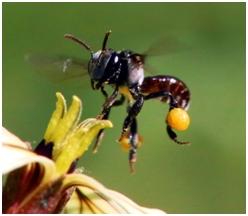Assessment of pollen assemblages from the hives of Tetragonula carbonaria for the presence of the threatened species Grevillea parviflora subsp. parviflora
DOI:
https://doi.org/10.26786/1920-7603(2016)13Abstract
Pollen assemblages from managed hives of the Australian social stingless bee Tetragonula carbonaria were examined for the presence of the threatened species Grevillea parviflora subsp. Parviflora. Managed hives of Tetragonula carbonaria were placed in bushland at Lake Macquarie, New South Wales, Australia, in four known populations of Grevillea parviflora subsp. parviflora through the main flowering period of 12 September to 2 November 2014. Samples of honey and propolis were collected from the hives at the end of this period and analysed using palynology techniques for the presence of Grevillea parviflora subsp. parviflora pollen. Grevillea parviflora subsp. parviflora pollen was detected in all propolis samples from the four study sites but was not found in the honey samples. Field observations identified that honeybees were the dominant insect visitor to Grevillea parviflora subsp. parviflora at all sites. There were no sightings of Tetragonula carbonaria foraging on Grevillea parviflora subsp. parviflora inflorescences during field observations. This study also demonstrates the application of managed hives of the Australian stingless bees Tetragonula carbonaria for monitoring floral diversity where propolis samples can be used to indicate plant species richness (biodiversity) and the presence of specific species relevant to conservation within their foraging area.

Downloads
Published
How to Cite
Issue
Section
License
Copyright (c) 2016 Danielle Lloyd-Prichard, Steven Lucas, Tim Roberts, Simon Haberle

This work is licensed under a Creative Commons Attribution 4.0 International License.
JPE is an open access journal which means that all content is freely available without charge to the user or his/her institution.
Authors who publish with this journal agree to the following terms:
1) Authors retain copyright and grant the journal right of first publication with the work simultaneously licensed under a Creative Commons Attribution License that allows others to share the work with an acknowledgement of the work's authorship and initial publication in this journal.
2) Authors are able to enter into separate, additional contractual arrangements for the non-exclusive distribution of the journal's published version of the work (e.g., post it to an institutional repository or publish it in a book), with an acknowledgement of its initial publication in this journal.
3) Authors are permitted and encouraged to post their work online (e.g., in institutional repositories or on their website) prior to and during the submission process, as it can lead to productive exchanges, as well as earlier and greater citation of published work (See The Effect of Open Access).
To assure a broader targeted audience, content will be included into databases (such as EBSCO) and directories (such as DOAJ).











